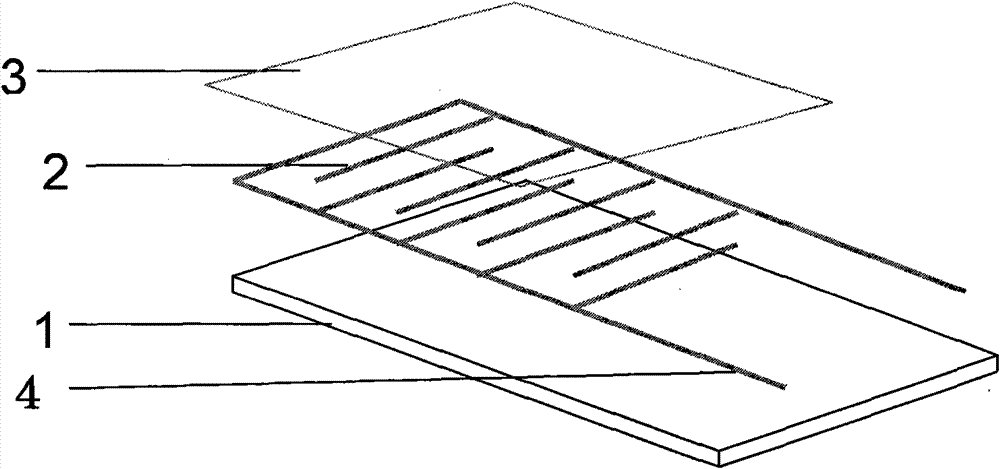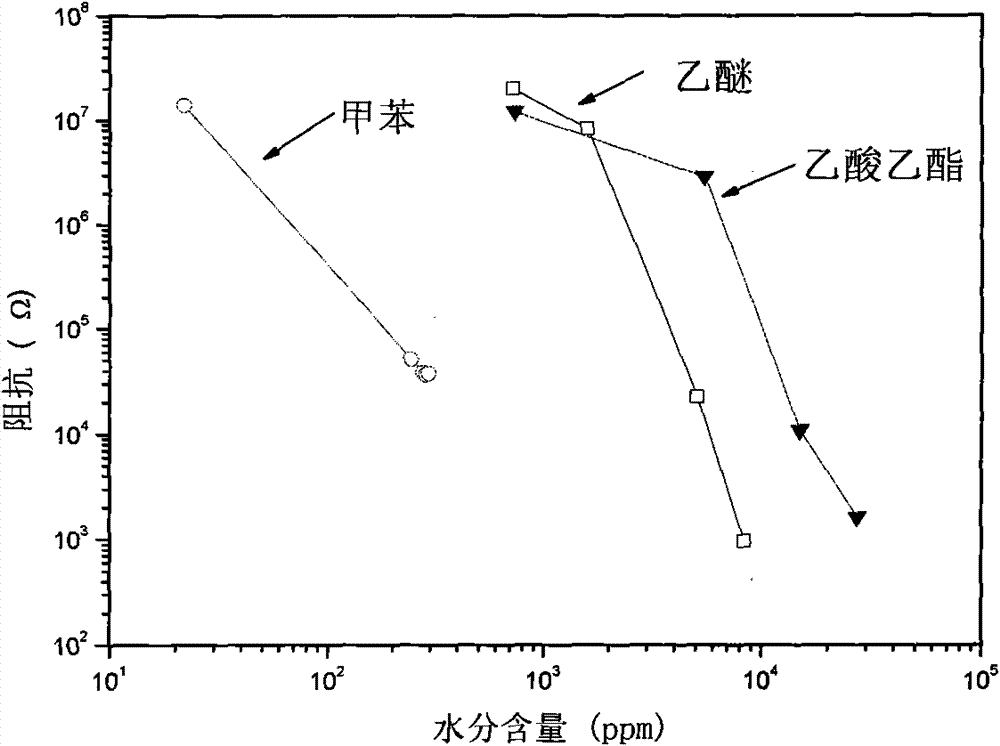Solvent water detection element based on conductive macromolecular compound and manufacturing method thereof
A technology of conductive polymer and solvent moisture, applied in the direction of material resistance, etc., can solve the problems of inappropriate determination of moisture content, difficulty in popularization, high price, and improve long-term stability and response reproducibility, easy measurement, and water absorption. reduced effect
- Summary
- Abstract
- Description
- Claims
- Application Information
AI Technical Summary
Problems solved by technology
Method used
Image
Examples
Embodiment 1
[0029] 1) Clean the ceramic substrate with interdigital gold electrode by lithography and evaporation, and dry it for later use;
[0030] 2) Prepare an aqueous solution of polystyrene sulfonic acid with a concentration of 0.15 g / ml, add aniline distilled under reduced pressure into it, add 10 ml of aniline per liter of polystyrene sulfonic acid aqueous solution, and stir at 0°C for 1 hour , And then add dropwise an aqueous solution with a concentration of 0.05 g / ml ammonium persulfate. The volume ratio of the polystyrene sulfonic acid aqueous solution and the ammonium persulfate aqueous solution is 2:1. After stirring and mixing, let stand for at least 12 hours, precipitate with acetone, and pump Filtering, washing with acetone, and vacuum drying at room temperature for 24 hours to obtain polyaniline nanoparticles;
[0031] 3) Under ultrasonic vibration, the polyaniline nanoparticles prepared in step 2) are formulated into an aqueous solution with a concentration of 20 mg / ml, and t...
Embodiment 2
[0034] 1) Clean the ceramic substrate with interdigital gold electrode by lithography and evaporation, and dry it for later use;
[0035] 2) Prepare an aqueous solution of polystyrene sulfonic acid with a concentration of 0.05 g / ml, add aniline distilled under reduced pressure into it, and add 10 ml of aniline per liter of polystyrene sulfonic acid aqueous solution, and stir for 1 hour at 0°C , And then add dropwise an aqueous solution with a concentration of 0.05 g / ml ammonium persulfate. The volume ratio of the polystyrene sulfonic acid aqueous solution and the ammonium persulfate aqueous solution is 2:1. After stirring and mixing, let stand for at least 12 hours, precipitate with acetone, and pump Filtering, washing with acetone, and vacuum drying at room temperature for 24 hours to obtain polyaniline nanoparticles;
[0036] 3) Under ultrasonic vibration, prepare the polyaniline nanoparticles prepared in step 2) into an aqueous solution with a concentration of 50 mg / ml, and then...
Embodiment 3
[0039] 1) Clean the ceramic substrate with interdigital gold electrode by lithography and evaporation, and dry it for later use;
[0040] 2) Prepare an aqueous solution of polystyrene sulfonic acid with a concentration of 0.20 g / ml, add aniline distilled under reduced pressure into it, add 10 ml of aniline per liter of polystyrene sulfonic acid aqueous solution, and stir at 0°C for 1 hour , And then add dropwise an aqueous solution with a concentration of 0.05 g / ml ammonium persulfate. The volume ratio of the polystyrene sulfonic acid aqueous solution and the ammonium persulfate aqueous solution is 2:1. After stirring and mixing, let stand for at least 12 hours, precipitate with acetone, and pump Filtering, washing with acetone, and vacuum drying at room temperature for 24 hours to obtain polyaniline nanoparticles;
[0041] 3) Under ultrasonic vibration, the polyaniline nanoparticles prepared in step 2) are formulated into an aqueous solution with a concentration of 5 mg / ml, and th...
PUM
| Property | Measurement | Unit |
|---|---|---|
| width | aaaaa | aaaaa |
| interdigital gap | aaaaa | aaaaa |
Abstract
Description
Claims
Application Information
 Login to View More
Login to View More - R&D
- Intellectual Property
- Life Sciences
- Materials
- Tech Scout
- Unparalleled Data Quality
- Higher Quality Content
- 60% Fewer Hallucinations
Browse by: Latest US Patents, China's latest patents, Technical Efficacy Thesaurus, Application Domain, Technology Topic, Popular Technical Reports.
© 2025 PatSnap. All rights reserved.Legal|Privacy policy|Modern Slavery Act Transparency Statement|Sitemap|About US| Contact US: help@patsnap.com



